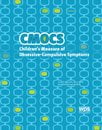
Childrens Measure of Obsessive-Compulsive Symptoms cmocs
For: Provides a psychometrically sound measure of obsessions, compulsions and their impact on daily functioning - anchored in DSM-IV criteria for OCD
Reading Level: 8 to 19 years
Format: Paper-and-Pencil
Length: 10 to 15 minutes
Scoring: Hand Scored
Printed Kits
Click to browse products
Printed Forms & Handscoring Materials
Test forms, response booklets and scoring reference manuals.
CMOCS Kit
CMOCS Autoscore Forms (25)
Authors
Cecil R. Reynolds, Ph.D., and Ronald B. Livingston, Ph.D.
Description Obsessive-Compulsive Disorder (OCD) is relatively common in children and teens, and its impact on daily functioning may be severe. Yet until now it has been difficult to assess – those who suffer from OCD tend to hide their symptoms; comorbid conditions often obscure its presence; and existing OCD instruments have been limited by inadequate normative and psychometric data.
A Self-Report Measure That’s Brief, Easy to Use, and Well Normed
Now there’s a new option for evaluating OCD – a brief, easy-to-administer, self-report inventory that offers both detailed and summary scores, all referenced to a large, representative norm sample. The new Children’s Measure of Obsessive-Compulsive Symptoms (CMOCS) assesses and quantifies the subjective experience of children and teens who have obsessions and/or compulsions at either a clinical or sub-clinical level.
The CMOCS is composed of 56 items covering six Problem Areas:
Fear of Contamination
Rituals
Intrusive Thoughts
Checking
Fear of Mistakes and Harm
Picking/Slowing
These scales address obsessions and compulsions and their impact on daily functioning. In addition, two validity scales alert you to inconsistent responding or defensiveness on the examinee’s part.
Problem Area Scores and Summary Scores Reflecting Severity and Impact
Group or individually administered in just 10 to 15 minutes, the CMOCS employs a simple self-report format, with a 4-point response scale, ranging from “Never” to “Almost Always.” Items are written at a second-grade reading level.
The test generates six Problem Area Scores plus two Summary Scores: the Total Score, indicating overall symptom level, and the Impact Score, reflecting the degree to which obsessions or compulsions interfere with daily functioning and cause distress. Both are strongly associated with clinical status.
Useful in Virtually Any Assessment Setting
Because it gives you both the big picture and a profile of specific obsessions and compulsions, the CMOCS is useful for various assessment purposes.
In clinical settings the test is a helpful diagnostic tool. The items are anchored in DSM-IV criteria for OCD; the norm-referenced scores help you determine whether symptoms are clinically significant; the rich, detailed score profile guides intervention planning; and the brevity simplifies symptom monitoring.
In school settings CMOCS results, particularly the Impact Score, may help you ascertain whether students meet IDEA criteria for Emotional Disturbance. They are also useful in creating IEPs, determining whether misbehaviour is a direct result of a student’s disability and measuring response to intervention.
In research settings the CMOCS may be used to establish baseline data, compare individual children or large groups, and identify sub-groups. CMOC’s strong normative sample and easy reading level make the test ideal for research applications.
The CMOCS answers the need for a psychometrically sound self-report measure of problematic obsessions and compulsions experienced by children and adolescents. The fact that it may be interpreted at both summary and specific levels makes this unique test widely useful.
NB: Prices are in Australian dollars inclusive of GST. NZ customers need to log in to view ex-GST prices.



